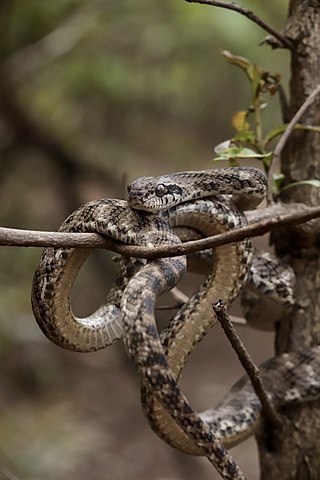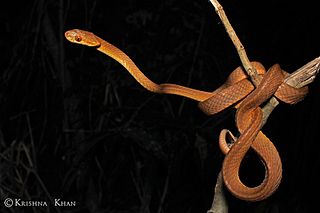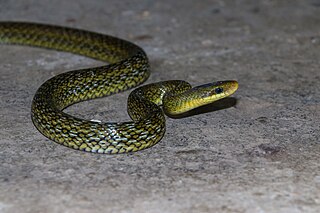
Phrynocephalus theobaldi is a species of lizard in the family Agamidae. The species is endemic to Asia.
The Assam keelback, commonly known as Peal's keelback, is a species of snake in the subfamily Natricinae of the family Colubridae. The species is endemic to Northeast India. It has recently been rediscovered after 129 years in Arunachal Pradesh.

The Himalayan keelback is a species of grass snake in the family Colubridae. The species is endemic to South Asia.

The Sikkim keelback is a species of grass snake in the family Colubridae. The species is endemic to South Asia and Myanmar. It is closely related to the Himalayan keelback, and some treat this species as a synonym.

Boiga forsteni, also known commonly as Forsten's cat snake, is a species of mildly venomous rear-fanged snake in the family Colubridae. The species is endemic to South Asia.

Boiga ochracea, commonly called the tawny cat snake, is a species of rear-fanged snake in the family Colubridae. The species is endemic to South Asia.

Boiga trigonata, commonly known as the Indian gamma snake or common cat snake, is a species of rear-fanged colubrid endemic to South Asia.

Gonyosoma prasinum is a species of colubrid snake found in Asia.

Elaphe hodgsoni, also known commonly as Hodgson's rat snake and the Himalayan trinket snake, is a species of snake in the family Colubridae. The species is native to parts of Asia around the Himalayas.
Oligodon theobaldi, commonly known as the Mandalay kukri snake or Theobald's kukri snake, is a species of snake in the family Colubridae. The species is endemic to Asia.
Ptyas nigromarginata, commonly known as the green rat snake or black-bordered rat snake, is a species of snake in the family Colubridae. The species is endemic to Asia.

Pseudoxenodon macrops, commonly known as the large-eyed bamboo snake or the big-eyed bamboo snake, is a species of mildly venomous rear-fanged snake endemic to Asia.

Sibynophis collaris, commonly known as the common many-toothed snake,Betty's many toothed snake or the collared black-headed snake, is a species of colubrid snake endemic to South and East Asia.
Jerdon's day gecko is a species of gecko, a lizard in the family Gekkonidae. The species is native to India and Sri Lanka.

Lawder's bent-toed gecko is a species of gecko, a lizard in the family Gekkonidae. The species is endemic to northern India. Its type locality is "Kumaon", restricted to Almora by Malcolm Arthur Smith. It is named after Mr. A. Lawder who collected the holotype. His identity is not known for sure, but he is likely to have been A.W. Lawder who was a member of the Geological Society of London, as was Ferdinand Stoliczka who described the species. It is sometimes placed in the genus Cyrtopodion.

Ophisops jerdonii, commonly known as Jerdon's cabrita, Jerdon's snake-eye, and the Punjab snake-eyed lacerta, is a species of lizard in the family Lacertidae. The species is native to South Asia.

Eutropis tytleri is a species of skink, a lizard in the family Scincidae. The species is endemic to the Andaman Islands, India.
Ophiomorus tridactylus, commonly known as the three-toed snake skink, is a species of skink endemic to sandy desert areas of South Asia. It is also called the Indian sand-swimmer for its habit of moving just under the sand.

Trachischium is a genus of snakes, known commonly as slender snakes or worm-eating snakes, in the subfamily Natricinae of the family Colubridae. The genus is endemic to Asia.
Blythia is a genus of snakes in the subfamily Natricinae of the family Colubridae of the superfamily Colubroidea. The genus, which contains two recognized species, is native to South Asia and Southeast Asia.














